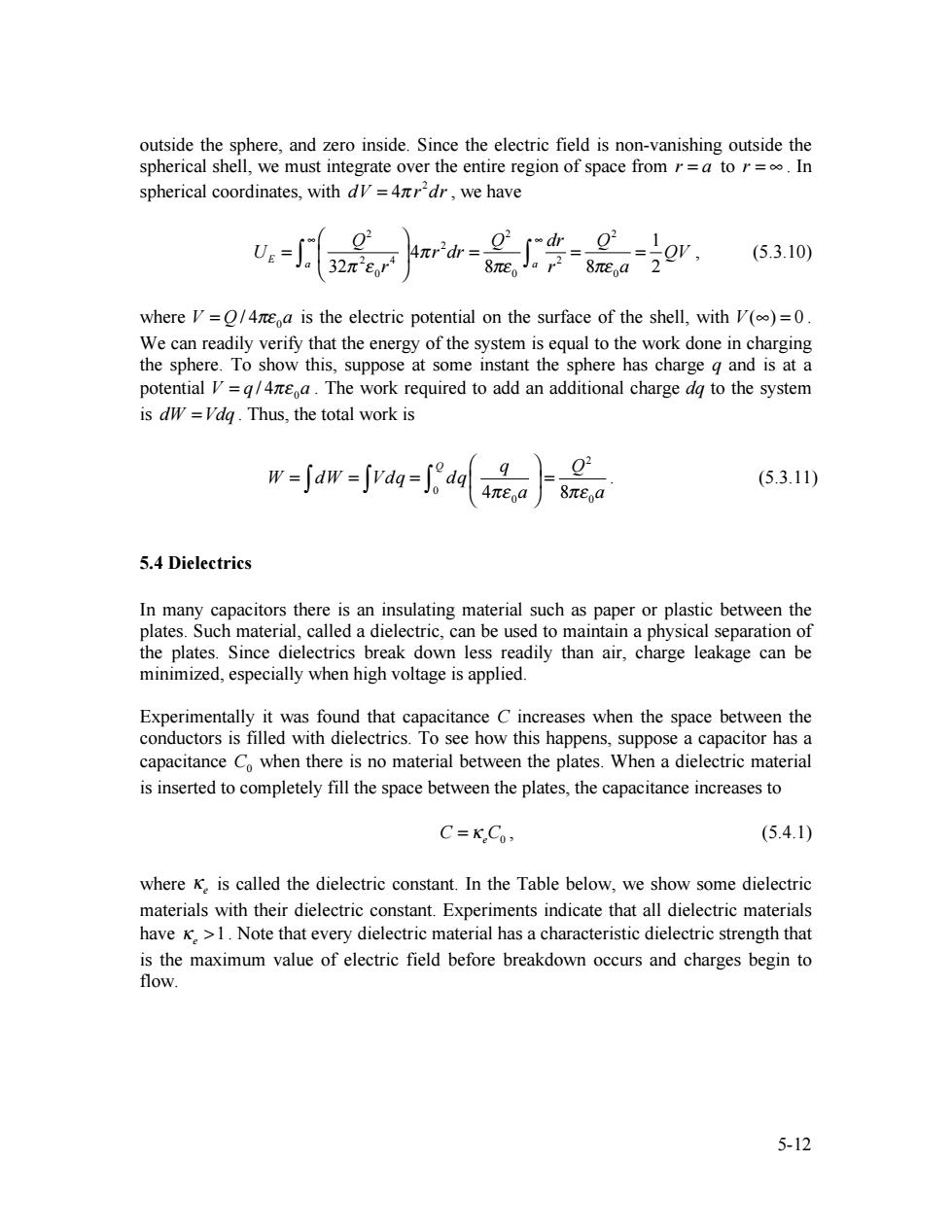正在加载图片...

outside the sphere,and zero inside.Since the electric field is non-vanishing outside the spherical shell,we must integrate over the entire region of space from r=a to r=.In spherical coordinates,with dy=4ur'dr,we have (5.3.10) where /=O/4ea is the electric potential on the surface of the shell,with V()=0. We can readily verify that the energy of the system is equal to the work done in charging the sphere.To show this,suppose at some instant the sphere has charge g and is at a potential V=g/4a.The work required to add an additional charge dg to the system is dw =Vdg.Thus,the total work is W-Sdw-Svdq-S'dq 9 o" 4πea (5.3.11) 8πeoa 5.4 Dielectrics In many capacitors there is an insulating material such as paper or plastic between the plates.Such material,called a dielectric,can be used to maintain a physical separation of the plates.Since dielectrics break down less readily than air,charge leakage can be minimized,especially when high voltage is applied. Experimentally it was found that capacitance C increases when the space between the conductors is filled with dielectrics.To see how this happens,suppose a capacitor has a capacitance Co when there is no material between the plates.When a dielectric material is inserted to completely fill the space between the plates,the capacitance increases to C=KCo, (5.4.1) where K.is called the dielectric constant.In the Table below,we show some dielectric materials with their dielectric constant.Experiments indicate that all dielectric materials have K.>1.Note that every dielectric material has a characteristic dielectric strength that is the maximum value of electric field before breakdown occurs and charges begin to flow. 5-125-12 outside the sphere, and zero inside. Since the electric field is non-vanishing outside the spherical shell, we must integrate over the entire region of space from r = a to r = ! . In spherical coordinates, with 2 dV = 4! r dr , we have 2 2 2 2 2 4 2 0 0 0 1 4 32 8 8 2 E a a Q Q dr Q U r dr QV r r a ! ! " !" !" # $ % # = & ' = = = ( ) * * , (5.3.10) where 0 V = Q / 4!" a is the electric potential on the surface of the shell, with V (!) = 0 . We can readily verify that the energy of the system is equal to the work done in charging the sphere. To show this, suppose at some instant the sphere has charge q and is at a potential 0 V = q / 4!" a . The work required to add an additional charge dq to the system is dW =Vdq . Thus, the total work is 2 0 0 0 4 8 Q q Q W dW Vdq dq !" a !" a # $ = = = % & = ' ( ) ) ) . (5.3.11) 5.4 Dielectrics In many capacitors there is an insulating material such as paper or plastic between the plates. Such material, called a dielectric, can be used to maintain a physical separation of the plates. Since dielectrics break down less readily than air, charge leakage can be minimized, especially when high voltage is applied. Experimentally it was found that capacitance C increases when the space between the conductors is filled with dielectrics. To see how this happens, suppose a capacitor has a capacitance C0 when there is no material between the plates. When a dielectric material is inserted to completely fill the space between the plates, the capacitance increases to C = !eC0 , (5.4.1) where !e is called the dielectric constant. In the Table below, we show some dielectric materials with their dielectric constant. Experiments indicate that all dielectric materials have 1 !e > . Note that every dielectric material has a characteristic dielectric strength that is the maximum value of electric field before breakdown occurs and charges begin to flow